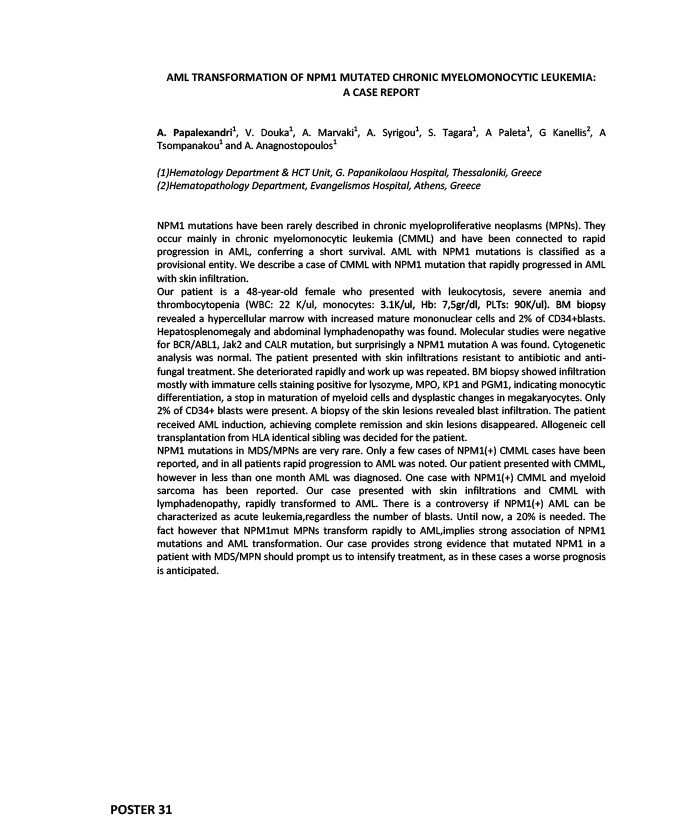
AML TRANSFORMATION OF NPM1 MUTATED CHRONIC MYELOMONOCYTIC LEUKEMIA:
POSTER 31
A CASE REPORT
A. Papalexandri1, V. Douka1, A. Marvaki1, A. Syrigou1, S. Tagara1, A Paleta1, G Kanellis2, A
Tsompanakou1 and A. Anagnostopoulos1
(1)Hematology Department & HCT Unit, G. Papanikolaou Hospital, Thessaloniki, Greece
(2)Hematopathology Department, Evangelismos Hospital, Athens, Greece
NPM1 mutations have been rarely described in chronic myeloproliferative neoplasms (MPNs). They
occur mainly in chronic myelomonocytic leukemia (CMML) and have been connected to rapid
progression in AML, conferring a short survival. AML with NPM1 mutations is classified as a
provisional entity. We describe a case of CMML with NPM1 mutation that rapidly progressed in AML
with skin infiltration.
Our patient is a 48-year-old female who presented with leukocytosis, severe anemia and
thrombocytopenia (WBC: 22 K/ul, monocytes: 3.1Κ/ul, Hb: 7,5gr/dl, PLTs: 90K/ul). BM biopsy
revealed a hypercellular marrow with increased mature mononuclear cells and 2% of CD34+blasts.
Hepatosplenomegaly and abdominal lymphadenopathy was found. Molecular studies were negative
for BCR/ABL1, Jak2 and CALR mutation, but surprisingly a NPM1 mutation A was found. Cytogenetic
analysis was normal. The patient presented with skin infiltrations resistant to antibiotic and anti-fungal
treatment. She deteriorated rapidly and work up was repeated. BM biopsy showed infiltration
mostly with immature cells staining positive for lysozyme, MPO, KP1 and PGM1, indicating monocytic
differentiation, a stop in maturation of myeloid cells and dysplastic changes in megakaryocytes. Only
2% of CD34+ blasts were present. A biopsy of the skin lesions revealed blast infiltration. The patient
received AML induction, achieving complete remission and skin lesions disappeared. Allogeneic cell
transplantation from HLA identical sibling was decided for the patient.
NPM1 mutations in MDS/MPNs are very rare. Only a few cases of NPM1(+) CMML cases have been
reported, and in all patients rapid progression to AML was noted. Our patient presented with CMML,
however in less than one month AML was diagnosed. One case with NPM1(+) CMML and myeloid
sarcoma has been reported. Our case presented with skin infiltrations and CMML with
lymphadenopathy, rapidly transformed to AML. There is a controversy if NPM1(+) AML can be
characterized as acute leukemia,regardless the number of blasts. Until now, a 20% is needed. The
fact however that NPM1mut MPNs transform rapidly to AML,implies strong association of NPM1
mutations and AML transformation. Our case provides strong evidence that mutated NPM1 in a
patient with MDS/MPN should prompt us to intensify treatment, as in these cases a worse prognosis
is anticipated.